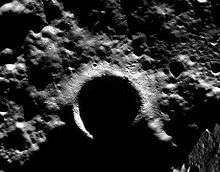Whipple (crater)
Whipple is a lunar impact crater located on the lunar far side near the northern pole. The crater is located East of the prominent craters Byrd and Peary; the latter of which it is located on the rim of.

| Coordinates | 89.1°N 118.2°E |
|---|---|
| Diameter | 15.7 km |
| Depth | 3.1 km |
| Eponym | Fred Lawrence Whipple |
Whipple is permanently shaded from the Sun. Volatile species of atoms and molecules, such as water (and mercury), that enter the crater freeze, and thus get trapped due to the extremely cold conditions that prevail within the crater. Moreover, Whipple crater's radar signature is characterized by a high, same-sense, circular-polarization ratio (CPR). This is thought to indicate that there are thick—at least 2 metres—ice deposits that are relatively pure. Such ice deposits represent a potentially valuable source of drinkable water, as well as rocket propellant in the form of liquid hydrogen and liquid oxygen (LH2/LO2).
In addition, Whipple is next to a large, quasi-permanently sunlit plateau that occupies its north rim. There, the sun is visible nearly 80% of the time on average; the temperature in such quasi-permanently sunlit areas is quite mild by Lunar standards, averaging approximately -50 °C, ± 10°. This combination of permanently shaded, high-CPR crater adjacent to quasi-permanently sunlit plateau is unique in the north polar region of the Moon.
Whipple was adopted and named after American astronomer Fred Lawrence Whipple by the IAU in 2009.[1]
References
- Andersson, L. E.; Whitaker, E. A. (1982). NASA Catalogue of Lunar Nomenclature. NASA RP-1097.CS1 maint: ref=harv (link)
- Blue, Jennifer (July 25, 2007). "Gazetteer of Planetary Nomenclature". USGS. Retrieved 2007-08-05.CS1 maint: ref=harv (link)
- Bussey, B.; Spudis, P. (2004). The Clementine Atlas of the Moon. New York: Cambridge University Press. ISBN 978-0-521-81528-4.CS1 maint: ref=harv (link)
- Cocks, Elijah E.; Cocks, Josiah C. (1995). Who's Who on the Moon: A Biographical Dictionary of Lunar Nomenclature. Tudor Publishers. ISBN 978-0-936389-27-1.CS1 maint: ref=harv (link)
- McDowell, Jonathan (July 15, 2007). "Lunar Nomenclature". Jonathan's Space Report. Retrieved 2007-10-24.CS1 maint: ref=harv (link)
- Menzel, D. H.; Minnaert, M.; Levin, B.; Dollfus, A.; Bell, B. (1971). "Report on Lunar Nomenclature by the Working Group of Commission 17 of the IAU". Space Science Reviews. 12 (2): 136–186. Bibcode:1971SSRv...12..136M. doi:10.1007/BF00171763.CS1 maint: ref=harv (link)
- Moore, Patrick (2001). On the Moon. Sterling Publishing Co. ISBN 978-0-304-35469-6.CS1 maint: ref=harv (link)
- Price, Fred W. (1988). The Moon Observer's Handbook. Cambridge University Press. ISBN 978-0-521-33500-3.CS1 maint: ref=harv (link)
- Rükl, Antonín (1990). Atlas of the Moon. Kalmbach Books. ISBN 978-0-913135-17-4.CS1 maint: ref=harv (link)
- Webb, Rev. T. W. (1962). Celestial Objects for Common Telescopes (6th revised ed.). Dover. ISBN 978-0-486-20917-3.CS1 maint: ref=harv (link)
- Whitaker, Ewen A. (1999). Mapping and Naming the Moon. Cambridge University Press. ISBN 978-0-521-62248-6.CS1 maint: ref=harv (link)
- Wlasuk, Peter T. (2000). Observing the Moon. Springer. ISBN 978-1-85233-193-1.CS1 maint: ref=harv (link)